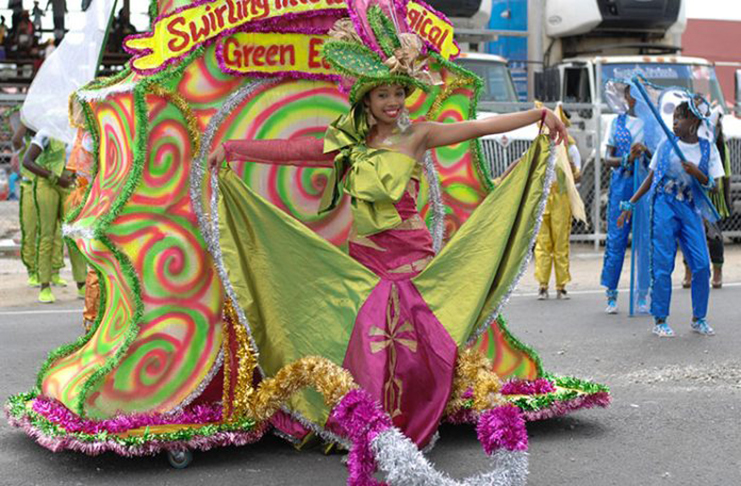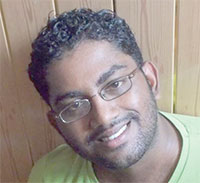MY earliest memory of Mashramani is from when I was about seven years old. My sister and I were being taken around the streets of Georgetown by our grandfather, who would point out the bright, colourful floats, and marvel along with us at the enthusiasm and energy of the dancers, generally serving as our guide as we walked through the densely, packed streets that pounded with stomping and music. I remember that early that day our grandfather had simply woken up and said something along the lines of, “Leh we go see the Mashramani.”
He was quite spontaneous like that. We went out. There was cotton candy. Our grandfather kept a steady supply of water ready for us whenever we got thirsty. He held our hands. He was quite responsible. However, at one point during the venture in the heart of the carnivalesque get-together that is Mashramani, I somehow lost him and my sister in the crowd.

And yet, strangely, I did not panic. You see, I was surrounded by colour and beauty and art. There was music and there was merriment and laughter and joy. Perhaps, the seven-year-old me, felt comforted or protected by that. Perhaps at that moment, I didn’t believe that anything could go wrong, that anything bad could possibly happen in a place of euphoria that was so strong that it drowned out everything else.
While reflecting on that incident, I had initially thought that the first lesson from that day was that Mash makes people happy. However, my adult mind has broken that down even more and edited that interpretation to say that art, as experienced during Mashramani, is really what makes people happy. Is it the thing itself, the holiday, the observance of Republic Day that makes the Mashramani celebration everything that it is? I would counter this by saying that it is really the artistic elements that shape the holiday that actually deserve to be recognised as the factors that define Mash.
Mashramani is the colourful costumes made from hundreds of beads and feathers. Mash is a set of artists and designers who stay up late into the night, drawing, cutting, pasting. Mash is calypso music written by witty, bawdy calypsonians. Mash is your “big auntie and all she chirren” who can dance like it is the last time they will ever get to dance. Mash is the food, prepared by generations of mothers before it makes its way to your plate. Mash is a thing with rhythm and flow. Mash is made of a thousand literary devices. Mash is art.
REPUBLIC DAY? THAT’S JUST THE EXCUSE.
But, going back to me misplacing my family, the possibility exists that, perhaps, it was only childishness after all, that caused me not to feel anything but awe and complacency when I realised that I was very much alone in a crush of bodies made up entirely of strangers. Perhaps the artistry within the celebrations had nothing to do with it, even though I do believe otherwise. Whatever the reason, I was quite calm as I made the decision to keep walking through the crowd, rather than waiting for my grandfather to find me.
I thought I saw him walking in front of me. The figure had on a white shirt similar to the one he was wearing, so I ran up and tugged at the person’s shirt. A beaming woman wearing a cutout of the map of Guyana on a headband turned to face me. Another woman said something that I can no longer remember to the beaming woman and the beaming woman laughed. I had not managed to find my grandfather at that moment, but instead, I found something else that would become much, much more important. Yes, that’s right. I can now say that that thing I found was more important than family. What was it that I found? Well, it was: knowledge.
This second lesson came about when I realised that by following the woman with the Guyana map headband, I had been led into a section of dancers I had not seen before. They were parading quite gaily and they wore white shirts with green writing on them. I realised with a slight shock – no doubt stemming from the early social conditioning that my PPP-supporting, African-fearing family members instilled in me – that I had made my way into what was probably the PNC’s Mash band, or at least a group of their supporters.
I say probably because it was a long time ago and I was really young, so I cannot be entirely sure. However, there was “PNC” on the shirts and that was when I realised that these were PNC supporters. I don’t think I was afraid or stunned. I was just interested, in the way we are as children, all fascinated with the forbidden, and I stood in the street watching them parade and dance. The moment of great knowledge, however, and the moment that truly shocked the seven- year-old me was when I realised that some of the people in the PNC band were (gasp!) “coolie” people.
They were dancing and having fun, proudly flaunting their dedication to the PNC. That was the moment when I realised that all Indian people do not support the PPP and that meant that all African people do not support the PNC either. As a child who was constantly told about the importance of supporting the “Indian party” by adults who probably meant well, it had never occurred to me that this kind of thing, this kind of cross-voting, was possible.
It is indeed ironic and beautiful to reflect on this experience, to look back on this moment of awakening and realisation, and see how far we have come, particularly in this modern time where the PNC-led APNU government won the last election because of a large number of votes from young “coolie” people. Despite that, we still do have a far way to go.
I think that like me, at that moment at that Mashramani, every Indian person and every African person in this country might have had a moment where he/she realises the difference between race and political party. What was that moment like for others in my generation?
Did they have a considerate parent and sibling who sat them down and explained the complexities of Guyanese politics? Were they surprised in the streets the way I was? Was it in some jarring and shocking way that they realised this important aspect of Guyanese politics? How did it happen for you? How are our stories similar and how are they different?
ART AND POLITICS
Art and politics – two important themes I encountered one Mashramani day many years ago.
When my grandfather found me just a few minutes later, everything returned back to normal.
He was scared then, but whenever the subject of me being lost at Mashramani came up later, the family, in the way of typical Guyanese people, would always laugh about that instance of almost-misfortune. It is only now that I realise how much insight I actually gained that day by being on my own, for just a few minutes. Being symbolically and literally separated from my family was enough to allow me to see things on my own, in my way, and after gaining more knowledge, I managed to interpret what they truly meant much later.
And that raises the question: do other people take away lessons or bits of wisdom from our Mashramani celebrations? Do they learn anything from it anymore? Do they see all that it is composed of, or do they only see the glitter and gloss? Do they see the racist politics bubbling underneath the flowers and feathers? Do they see the underpaid artists struggling under the weight of their costumes? What do they see? What do you see?
If they only see a party; an opportunity to get drunk and have fun, then that spells doom for Mash and the entire nation. There are lessons and pieces of wisdom everywhere. All you have to do is look and you will find them.



.jpg)








